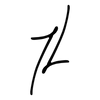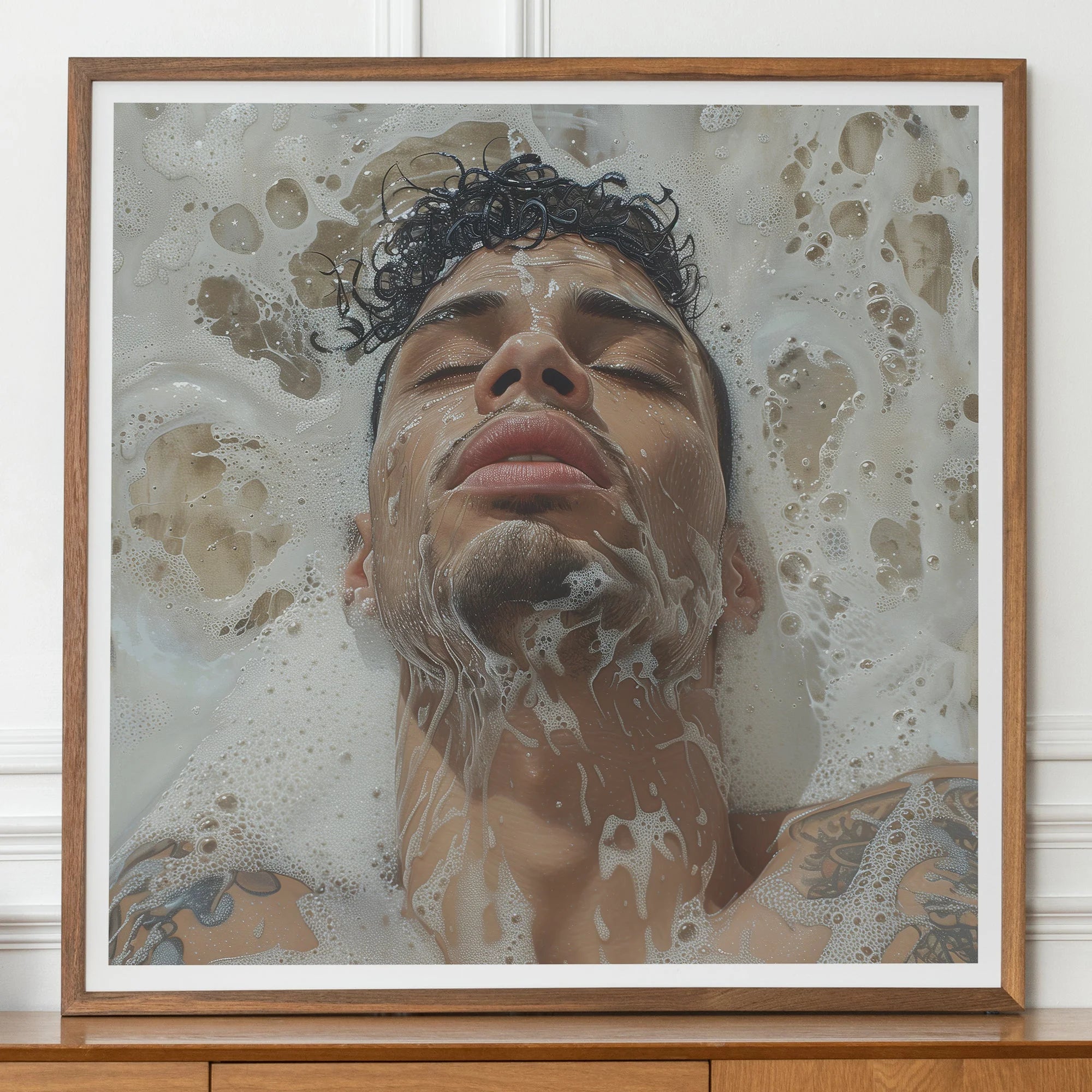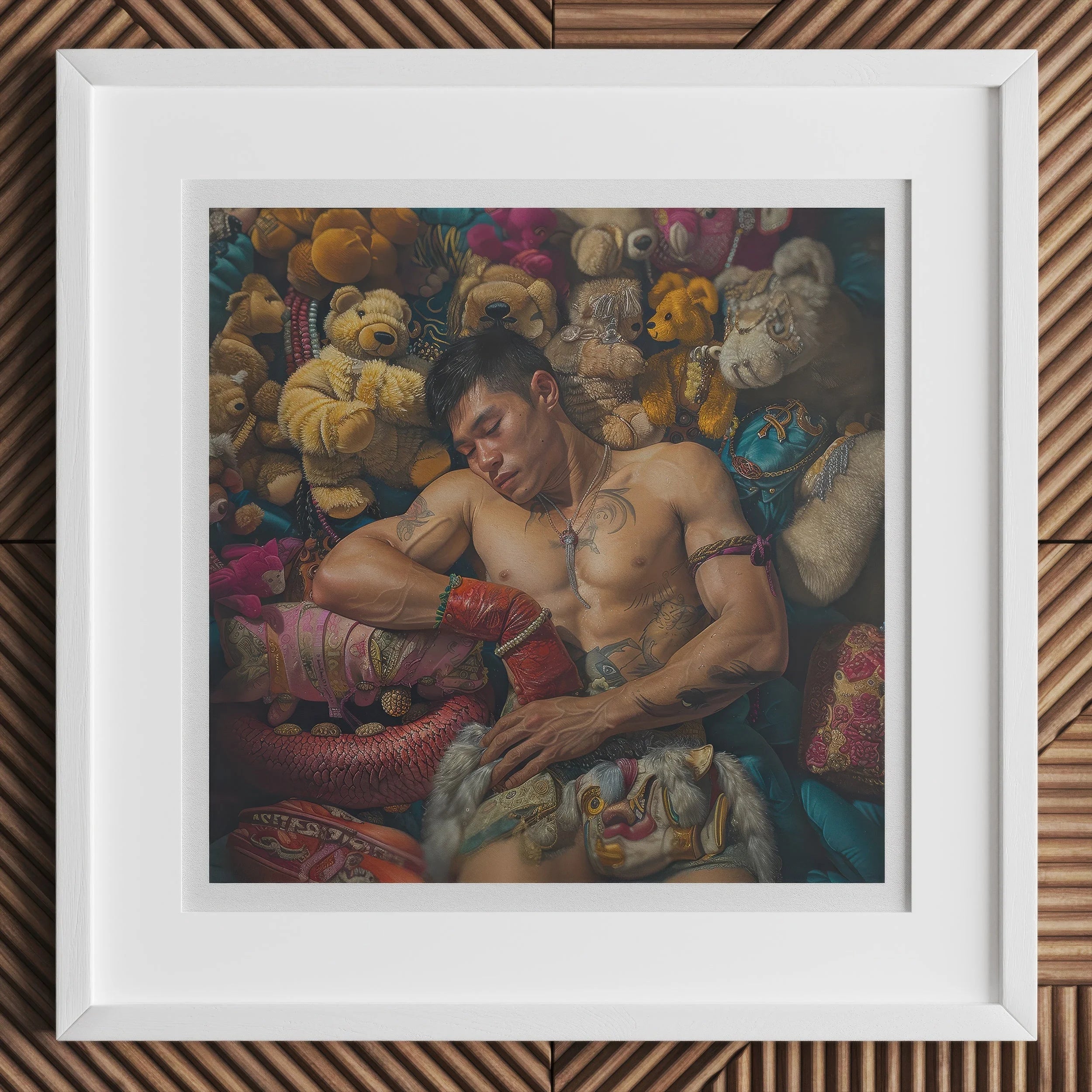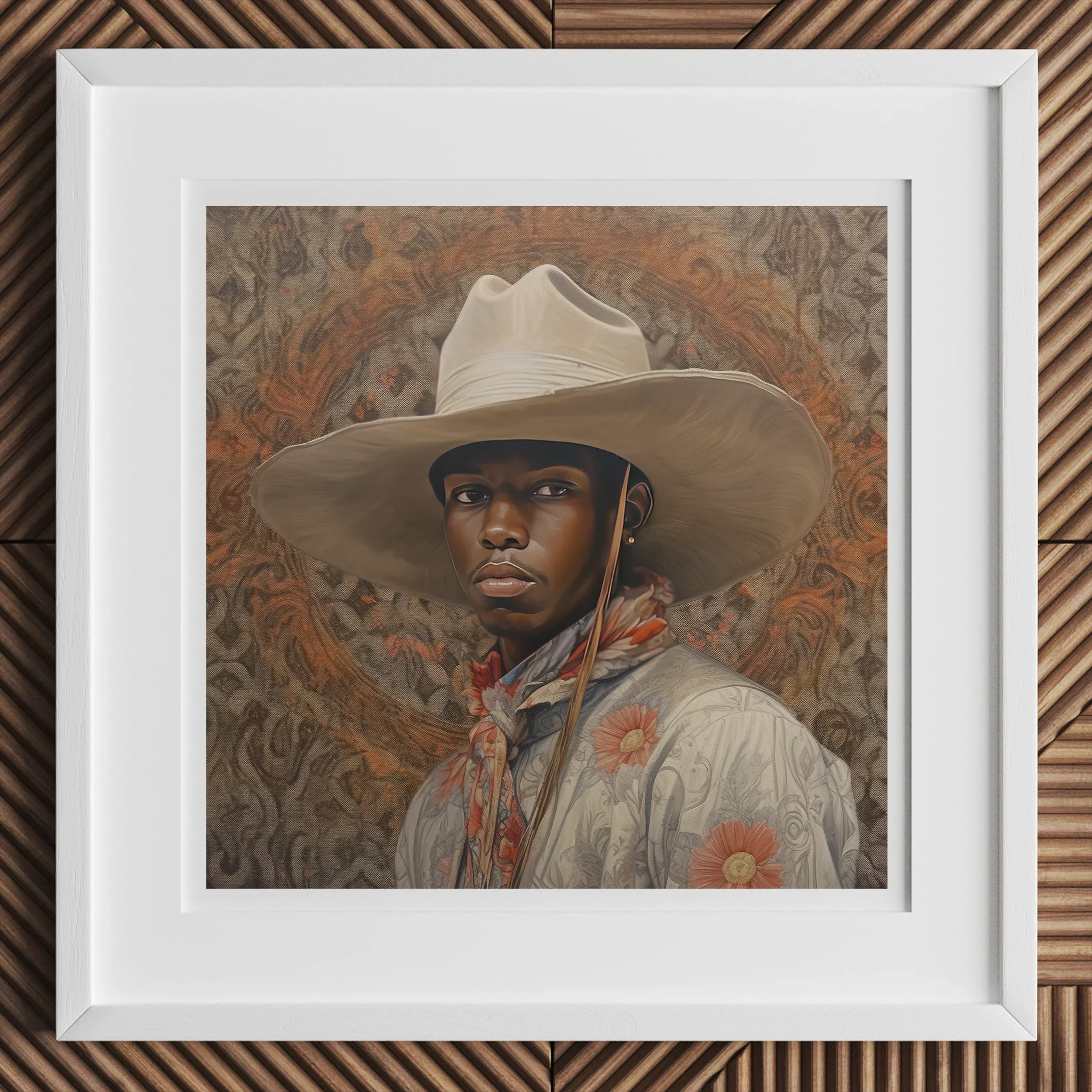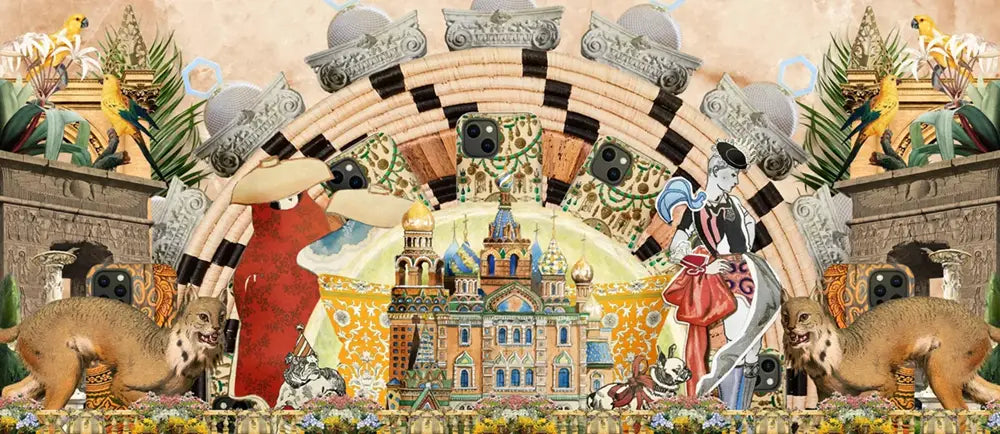Hidden Gay Codes & Symbols in Art History, Culture and More Stuff Queers Are Great At...
The history of gay coded symbols in art is not merely a collection of secret handshakes or furtive glances. It’s a grand, insurgent opera, scored in the margins of repression, painted onto canvases no one dared call queer until long after the paint had dried. Across centuries, creative queers have defied the silence imposed upon them — speaking in floral arrangements, whispered myths, flashes of color, and languages spun from theater smoke and street slang.
When speaking openly about one's gayness could invite exile, imprisonment, even death — and still can, depending on which scrap of Earth you find yourself — these symbols became lifelines. Luminous fractures through otherwise muted histories.
And somehow, through it all, queer symbolism in art remained f**king fabulous. Not despite danger — because of it. Risk and beauty, intertwined like lovers hiding in a grove of violets.
What we trace here is not an exhaustive encyclopedia of secret signals, nor a sterile taxonomizing of coded glances. This is a living map. A celebration of queer survival strategies that transformed marginalization into a vibrant, rebellious visual lexicon.
Importantly, the queer symbols we’re threading through the loom of this piece mostly arise in the last two hundred years. Why? Because before the industrial churn of the nineteenth century, before Freud named what should have stayed wild, the very notion of sexual "identity" — with its sharp borders and medicalized labels — didn't exist. Desire was a river, not a canal. Identity, a weather pattern, not a cage.
It was only with the advent of modern science and medicine — intertwined with fervent moral panic and legislative brutality — that homosexuality was pathologized, criminalized, and segregated into something that needed hiding or fixing.
Thus: the secret languages. Thus: the blooming of codes. Thus: the breathtaking ingenuity of queer people refusing to be erased.
This post invites you to wander through that ingenious landscape. To touch the green carnations and violet petals, the shimmering peacock feathers, the coded folds of handkerchiefs, the whispered myths, the velvet words of Polari. To see — not just the defiance — but the devastating beauty of survival turned into art.
Key Takeaways
-
Secret Codes of Defiance: Queer artists have long woven coded symbols and hidden languages into their art, crafting daring messages of rebellion and identity. These clandestine flourishes allowed expressions of love and selfhood in eras when openness risked exile, persecution, or death.
-
Blossoms and Feathers in Bold Rebellion: From Oscar Wilde's mischievous green carnation to extravagant peacock feathers, nature’s beauty has become a riotous queer emblem, proudly defying societal norms. Such delicate tokens offer winks of recognition to those in the know, turning simple gestures into vibrant acts of resistance.
-
From Oppression to Empowerment: The pink triangle, initially a chilling emblem forced upon queer prisoners by Nazis, was transfigured by LGBTQ+ activists into a fierce badge of pride, resilience, and revolution. This transformation embodies the queer art of reclaiming painful legacies, weaving strength from threads of sorrow.
-
Mythology’s Unbridled Queerness: Ancient gods and mythic heroes—free from restrictive binaries—danced boldly across gender and desire. Queer artists have continually invoked this mythological fluidity, cloaking their truths in legendary disguises, and crafting bold visual poetry that whispers secrets through classical tales.
-
Polari: Words Like Velvet Daggers: Born in the shadows of theatres and markets, Polari was the secret, sparkling language of queer solidarity and survival. With playful audacity, it blurred linguistic borders, allowing queer voices to flourish safely and stylishly, laying the foundation for contemporary LGBTQ+ slang and artful self-expression.
But... What Even Is Queer Art?
Queer art isn’t a set of pretty posters pinned under museum glass. It’s an instinct. A rupture. A thrum under the skin that knows when to smirk at power and when to burn it to ash.
Most queer artists couldn’t give a damn about the shrink-wrapped stereotypes society keeps trying to force them into — the brittle, barcoded labels about what it means to be "proper," "normal," "acceptable."
Throughout history, queer art has been a joyful heresy, a defiant thumb in the eye of conventional norms. It’s not just about "representation," though representation matters. It’s about what happens when you know the rules so well you can smash them to powder and rebuild something feral, something free.
In the rubble of polite society's expectations, queer artists plant gardens.
Not carefully manicured rows, mind you — but wild, riotous, tangled jungles that refuse to apologize for their existence.
Queer art is the blueprint for a life unlived by permission. A map scrawled in the margins. A language of becoming — scrawled across forbidden walls, sewn into theater costumes, tucked between the folds of code and myth.
Queer artists have almost always been the rebels, the pioneers, the shapeshifters. The ones who glance at the rigid scaffolding of society and say, with a flick of a paintbrush, a camera flash, a whispered word: No, not like that. Like this.
And in doing so, they give voice to the voiceless. They create a visual, visceral language for those who refuse to be erased — for those who know that truth doesn’t always announce itself politely at the dinner table. Sometimes, it kicks in the door wearing sequins and demands a dance.
Which is precisely why queer art remains a ferocious, political, and celebratory force to this day. Because the act of living — visibly, joyously, differently — is still a rebellion.
Because painting your own existence across the world’s walls, especially when that existence has been deemed disposable, is still revolutionary.
Now, let’s throw open the gates. Let’s step deeper into the lush labyrinth of queer codes, secret histories, and sparkling symbols scattered through art, culture, and everyday acts of defiance. Each one a seed. Each one a spell. Signs of self-expression, freedom of thought, and the making-divine of otherness — again and again, with every generation bold enough to refuse to disappear.
1
The Green Carnation
 The Queer Code: Secret Languages of LGBTQ+ Art via the National Galleries of Scotland
The Queer Code: Secret Languages of LGBTQ+ Art via the National Galleries of Scotland
...
The green carnation became a popular symbol of gay identity when Oscar Wilde, ever the architect of mischief and beauty, instructed his inner circle to wear green carnations to the opening of Lady Windermere’s Fan. A simple flower, dyed unnaturally green, pinned to the lapel: it didn’t scream rebellion — it whispered it, elegant and defiant.
The green carnation slipped into fashion as a queer coded symbol, an unspoken signal for those attuned to the pulse beneath society’s stiff veneer. It embodied the spirit of the Aesthetic Movement, which celebrated artifice, decadence, and beauty for its own lush, unapologetic sake — rejecting the puritanical cult of "natural" morality.
In a world obsessed with rigid binaries of nature versus artifice, purity versus perversion, the green carnation tilted its head and smiled. It flaunted its "unnatural" hue, mocking Victorian sensibilities that clutched at "normalcy" like a dying prayer. It was, in its quiet elegance, a rebellion tucked neatly into a buttonhole.
Oscar Wilde and his companions used the flower to thumb their noses at a society terrified of difference. To wear a green carnation was to exist — defiantly, beautifully — in a world that demanded your silence. It was a flash of color where only gray conformity was permitted, a living badge of artful dissent.
Today, the green carnation still lingers in queer memory. It is worn by organizations and artists who recognize that survival often blooms in the smallest gestures — a splash of forbidden color pinned proudly over the heart.
Gay Coded Green Carnations: A Legacy in Literature and Film
Green Carnations in Literature
-
"The Green Carnation" by Robert Hichens:
Published anonymously in 1894, this sly satire skewered Wilde’s social circle. Following Wilde’s scandalous trial, the novel was hastily withdrawn, its playful subtext suddenly too dangerous to print — a reminder that even coded rebellion was never truly safe. -
"The Green Carnations: Gay Classics Boxed Set":
A curated collection celebrating queer literary heritage, featuring Wilde’s The Picture of Dorian Gray, Bayard Taylor’s Joseph and His Friend, Theodore Winthrop’s Cecil Dreeme, The Sins of the Cities of the Plain, and others. A literary garden blooming defiantly against time’s erasures.
Green Carnations in Film
-
"An Ideal Husband" (1999):
In this film adaptation, a green carnation chosen for a character’s buttonhole serves as a subtle homage to Wilde’s legacy, a whisper of hidden meanings still alive on contemporary screens. -
"The Green Fog" by Guy Maddin:
While not featuring carnations explicitly, this experimental homage reimagines cultural memory, swirling queerness and coded histories into a surreal visual tapestry — much like Wilde’s own subversive aesthetics.
Other Flowers That Have Become Queer Symbols
Flowers have long been the clandestine co-conspirators of queer expression, their petals carrying messages more eloquent than spoken words.
-
Violets:
Since the 6th century, violets have been associated with lesbian love, largely thanks to the Greek poet Sappho of Lesbos, whose verses wove garlands of longing in fragrant bloom. -
Pansies:
In the early 20th century, the flamboyant "Pansy Craze" redefined pansies as emblems of gay identity. Though "pansy" began as a slur, queer activists reclaimed it, transforming insult into celebration — a linguistic flower unfurling defiantly toward the sun.
From Carl Van Vechten’s vibrant Harlem portraits to Robert Mapplethorpe’s stark, sensual florals, flowers have persisted as vessels of sensuality, difference, and untamed beauty in queer art. Each bloom: a secret offered, a world reinvented.
2
Peacock Feathers

 Birds of a Feather by Varad Bhamburdekar
Birds of a Feather by Varad Bhamburdekar
...
In the muted tapestry of Victorian society, where conformity pressed upon every corset string and cravat knot, the peacock feather unfurled itself like a wink from another universe.
In the late 19th and early 20th centuries, during the shimmering fever dream of the Victorian Aesthetic Movement, fashion became a language unto itself — and symbols became passports to secret selves.
Flowers, handkerchiefs, fans — all played double roles as decorative flourishes and clandestine signals. But it was the male peacock’s flamboyant train, absurdly lush and defiantly unnecessary, that captured the queer imagination most fiercely.
While the peahen cloaked herself in modest earth tones, the male unfurled his impossible grandeur — a dazzling rebellion against drabness, a living manifesto of non-heteronormative beauty.
Wearing a peacock feather became a whispered conversation stitched into one's outfit: a marker of solidarity, desire, otherness.
Gay men, following the ripple effect of Oscar Wilde’s green carnation, would tuck the iridescent plumes into their hats or lapels, signaling their identities to those alert enough to notice.
It wasn’t merely the extravagance that seduced — it was the deliberate excess.
The world prized restraint; the peacock demanded to be seen. And through its vibrant defiance, queer identity found another vessel.
Queer Coded Peacock Feathers
Edmund Dulac’s "Charles Ricketts and Charles Shannon as Medieval Saints" (1920)
In this layered painting, Charles Shannon cradles a peacock feather — a flash of coded significance amid ecclesiastical imagery. A dialogue unfolds between holiness and hidden longing, the sacred and the scandalous. Dulac’s brush offers a conversation in symbols: an invitation to peel back the pious veneer and glimpse the shimmering, forbidden truths beneath.
Here, the peacock feather becomes more than mere ornament — it becomes a cipher.
A way for queer viewers to recognize themselves in art without ever hearing their names spoken aloud.
3
The Hanky Code

 Tom Allen guesses LGBTQ slang terms and explains gay handkerchief code via Attitude Magazine
Tom Allen guesses LGBTQ slang terms and explains gay handkerchief code via Attitude Magazine
...
In the labyrinth of 1970s San Francisco, where glitter clung to leather and revolution hung heavy in the air, the humble handkerchief became a secret dialect stitched into denim seams. The hanky code — or flagging — wasn’t just about flirtation; it was an act of cartography, mapping the unspoken territories of queer desire.
A flash of fabric, a twist of color peeking from a back pocket, and suddenly a conversation unfurled — wordless yet electric.
Each hue, each placement, revealed a constellation of preferences: who sought dominance, who craved surrender, who desired connection outside the suffocating binaries imposed by a hostile world.
Originating in the working-class neighborhoods of San Francisco, where colored bandanas were worn for practical reasons among laborers and bikers, the hanky code blossomed into a full-fledged lexicon of sexual expression.
In a time when homosexuality was criminalized and queerness forced underground, these modest swatches of cloth became revolutionary badges of autonomy.
A piece of cotton tucked into denim — and you could say everything forbidden to say out loud. A language stitched from necessity, exuberance, and a refusal to remain invisible.
The Hanky Code in Queer Art and Culture
The Hanky Code in Art
-
Hal Fischer’s "Gay Semiotics":
Fischer’s groundbreaking photo series systematically cataloged the meanings embedded in each colored hanky, creating an audacious, satirical blueprint of gay visual language.
His work continues to ripple outward, recycled, referenced, and revered across exhibitions, zines, and queer theory syllabi alike. -
Queer Ecology Hanky Project:
In a vibrant act of reclamation, over 125 artists have reimagined the hanky code through wearable art — expanding its definitions to honor a kaleidoscope of bodies, identities, and practices beyond the original gay male frameworks. -
Brad Guy’s Photography Series:
Teaching about the hanky code through arresting visual storytelling, Guy’s work reanimates the language for a new generation, stitching the past to the present with color and light.
The Hanky Code in Literature
-
"Yes I'm Flagging: Queer Flagging 101" by Archie Bongiovanni:
An illustrated zine that captures the nuance and playfulness of nonverbal queer communication.
It reintroduces the lost art of flagging — a love letter to casual hookups, deep connection, and everything in between, told in vibrant ink.
The Hanky Code in Film
-
"Hanky Code: The Movie" (2015):
An anthology stitched together from 25 short films by queer directors worldwide, each vignette a kaleidoscopic exploration of color, kink, and clandestine storytelling — reminding us that flags don’t just mark territory; they tell stories.
4
The Pink Triangle

 Documenting Nazi Persecution of Gays: Josef Kohout/Wilhelm Kroepfl Collection (Curators Corner #13) via the United States Holocaust Memorial Museum
Documenting Nazi Persecution of Gays: Josef Kohout/Wilhelm Kroepfl Collection (Curators Corner #13) via the United States Holocaust Memorial Museum
...
It began in the shadows, stitched onto the coarse uniforms of those the Nazis deemed unfit to exist. The pink triangle, sewn crudely onto the breast pockets of gay men in concentration camps, marked them for further humiliation, isolation, and brutality — even among the damned.
Yet when the gates swung open at war’s end, liberation was cruelly partial. Where others were freed, many men bearing the pink triangle were dragged back into prisons, condemned once again under anti-homosexual laws that outlasted the Reich itself. Freedom, for them, remained a distant and flickering promise.
But queer alchemy thrives on the raw material of sorrow. What was meant to brand shame became a symbol of staggering defiance. In the crucible of the 1980s AIDS crisis, as governments turned blind eyes and entire communities fell under siege, the pink triangle was reclaimed — not as a wound, but as a weapon of resistance.
ACT UP — the AIDS Coalition to Unleash Power — unfurled the pink triangle against a backdrop of righteous fury, emblazoning it across posters, banners, and bodies. "Silence = Death," they wrote beneath it, turning silence itself into an indictment.
Today, the pink triangle stands not merely as a memorial to cruelty, but as a living testament to the enduring rage, brilliance, and resilience of LGBTQ+ resistance. A shape carved from suffering. A color reborn in pride.
The Pink Triangle in Queer Art and Culture
The Pink Triangle in Literature
-
"The Men With the Pink Triangle" by Heinz Heger:
A searing first-hand account that chronicles life inside the camps for those forced to wear the pink triangle — an unflinching testimony to survival against erasure. -
"Branded by the Pink Triangle" by Ken Setterington:
A critical examination of how the symbol’s meaning evolved from a mark of persecution into a global emblem of LGBTQ+ rights and remembrance.
The Pink Triangle in Film
-
"The Pink Triangle" (2020):
A poignant dramatization of a gay Nazi soldier navigating the treacherous tightrope of secrecy and survival — a meditation on identity under impossible conditions. -
"The Rocky Horror Picture Show":
Within the chaos and glitter of Frank N. Furter’s domain, the pink triangle flashes briefly — a sly nod to the history of coded rebellion stitched even into camp.
The Pink Triangle in Art and Activism
-
ACT UP’s Logo:
The pink triangle, inverted and defiant, became the rallying cry for AIDS activists worldwide, turning grief into galvanizing force, silence into screaming art.
5
Classical and Mythological Identities


Desire, Love, Identity: Exploring LGBTQ Histories via The British Museum
Before psychiatrists penned diagnoses, before governments legislated the policing of love, there were the gods — gleaming, capricious, boundaryless. To them, gender was a suggestion, not a sentence. Desire a compass, not a chain.
Across the ancient world — from Greece to Rome, Maya lands to the Arctic ice — queer fluidity thrived in myth and memory, woven into the very fabric of sacred stories.
In those days, before sexuality was cleaved into categories, queer love flowed freely through gods and mortals alike. It wasn’t revolutionary. It simply was.
As modernity locked down desire with labels and laws, queer artists turned back to these myths — plundering them for camouflage, for kinship, for coded truths hidden in plain sight.
Olympian Loves and Mortal Bonds
-
Apollo and Hyacinthus:
Apollo, the sun-god with golden hair and golden hunger, fell deeply for the mortal youth Hyacinthus. Their romance, sung in the wind and whispered by rivers, ended in tragedy — a discus thrown in love, twisted by jealous gods into a mortal wound. From Hyacinthus’s blood sprang the hyacinth flower, forever a symbol of queer mourning and eternal devotion. -
Achilles and Patroclus:
In Homer’s Iliad, the bond between Achilles and Patroclus thrums beneath every battle cry. Whether read as friendship or fierce love, their connection defied the expectations of masculine duty — a tapestry of tenderness stitched inside a brutal epic. -
Hadrian and Antinous:
When the Roman Emperor Hadrian lost his beloved Antinous — a youth of mesmerizing beauty — he deified him. Statues, temples, and cults spread across the empire, not just memorializing a boy, but enshrining queer love in the marble bones of civilization itself.
Queer Echoes Beyond the West
-
Maya Mythology – The Daring God Chin:
In the lush cosmologies of the Maya, the god Chin introduced homoerotic partnerships among noble families. His bold example fostered bonds between young men that mirrored matrimonial unions — another fierce reminder that queerness is not a Western invention, but a human constant. -
Inuit Mythology – Aakulujjuusi and Uumarnituq:
In the frozen breath of Inuit legend, the first humans — both male — fell in love. One transformed to bear their child, and in that miraculous birth, the seeds of war and creation were sown. It doesn’t "make sense" by Western binaries — and that's the point.
Myth remembers what textbooks forget: that love reshapes worlds, even the frozen ones.
Cloaking Queer Truths in Classical Robes
As times darkened and queer lives were criminalized, artists smuggled their desires through classical allegory.
They painted longing into myth, carved it into marble, and wrapped it in the sanctioned holiness of antiquity — disguising rebellion as reverence.
-
Frederic Leighton’s "Daedalus and Icarus":
This lush rendering hints at more than a simple myth of flight and fall.
Daedalus’s devotion to Icarus flickers with homoerotic undercurrents, subtly invoking the ancient Greek traditions of mentor-love — a relationship neither sinful nor shameful in its original telling. -
Michelangelo’s Sonnets:
Addressed to the young nobleman Tommaso dei Cavalieri, Michelangelo’s verses pulse with yearning too profound to dismiss as mere "friendship."
His poems stand today as monuments of queer affection disguised in classical cadence. -
The Renaissance’s Queer Undercurrents:
Beneath the grand domes and gilded frames, queer love flickered in shadowed glances and secret brushstrokes.
Figures like Leonardo da Vinci and Michelangelo infused their art with a subtle homoerotic tension — a palimpsest of longing erased and re-inscribed with every passing century.
Queers in Classic Literature
-
"The Picture of Dorian Gray" by Oscar Wilde:
Draped in decadent prose, Wilde’s novel thrums with homoerotic tension.
Basil Hallward’s worshipful adoration of Dorian, Lord Henry’s provocative mentorship — these are not merely friendships but coded reflections of queer desire dancing at the edge of Victorian censure. -
"Maurice" by E.M. Forster:
Written in the suffocating silence of Edwardian England but published posthumously, Maurice unspooled a tender narrative of same-sex love refusing to end in tragedy — a radical act when even hope was criminalized.
Queer artists looked backward not with nostalgia but with defiance.
They saw in ancient myths a mirror — one that reflected not sanitized identities, but the wild, restless truths of love, body, and spirit.
Through marble gods and mythic heroes, through mourned lovers and deified youths, they carved space for themselves against the grinding gears of erasure.
In the myths, they found not only ancestors, but ammunition.
6
Polari: The Secret Language

 How gay men used to speak - A short film in Polari via Brian & Karl
How gay men used to speak - A short film in Polari via Brian & Karl
...
Before Pride flags rippled in city squares, before hashtags and parades stitched queerness into public consciousness, there was Polari — a sly, lilting dialect crafted for survival and subversion.
From the 1930s to the 1960s, Polari thrived in London’s shadowy corners — backstage in theaters, among fishmongers at bustling markets, beneath the greasepaint of circus tents.
An evolving chimera of Romance languages, Cockney rhyming slang, Romani, Yiddish, and the argot of sailors and street performers, Polari shimmered where legality and morality clashed.
In a world where even suspicion could ruin lives, Polari offered not just discretion, but flair. A velvet verbal mask. A way to live and flirt and scheme without spelling oneself into danger. Where "normal" speech brought risk, Polari turned everyday conversation into performance art — sly, defiant, and deliciously camp.
It wasn’t confined to the gay community alone.
Actors, fairground showmen, fishwives — all bent its slippery syllables to their needs. But for gay men and drag queens in particular, Polari became a lifeline — a crackling code stitched from survival and sass.
Even after the decriminalization of homosexuality in Britain in 1967, Polari lingered — a secret inheritance, whispered across generations eager to remember how language itself could be armor and art.
Polari in Queer Art and Culture
Polari in Art
-
Zackary Petot:
In his lush, layered works, Petot intertwines Polari with printmaking, digital manipulation, and drawing — reviving the language as a vibrant contemporary tapestry, not a relic. -
Sisters of Perpetual Indulgence:
This order of queer nuns appropriates Polari for ceremonial magic and joyful blasphemy, blending theatricality with sacred mischief.
Polari in Literature
-
"Fabulosa!: The Story of Polari, Britain’s Secret Gay Language" by Paul Baker:
A rollicking, meticulous dive into Polari’s tangled roots and shimmering afterlives. -
"Polari – The Lost Language of Gay Men" by Paul Baker:
An academic yet affectionate exploration of how this hidden tongue shaped (and still shapes) queer identity.
Polari in Film
-
"Putting on the Dish" (2015):
Two men on a park bench, exchanging hopes and heartaches entirely in Polari — a tender, acerbic glimpse into coded connection. -
"Velvet Goldmine" (1998):
Amid glam rock’s glittered anarchy, Polari slips onto the screen, another spark from history’s queer bonfire.
Final Thought: The Trailblazing Art of Gay Symbolism
To unmask the glittering, snarling, heartbreakingly tender archive of gay coded art is to pull history’s attic door wide open — letting sunlight flood the rooms where queer lives once whispered for fear of the world’s wrath.
These symbols — carnation blooms, peacock feathers, handkerchiefs dyed into secret rainbows, pink triangles burning against gray uniforms — they were never static. They lived and breathed alongside their creators, shifting shape as each generation needed.
To trace them now is not just an academic exercise. It’s a resurrection.
It’s standing before the cracked mirror of time and watching ghostly fingers scrawl messages meant for those who could not yet exist — for us. For every queer soul who would someday look back and see not emptiness, but a labyrinth of signs saying I was here. I loved. I fought. I endured.
Each shift in medium — painting to photography, literature to graffiti, hand fans to hashtags — reveals how the coded language of survival evolved with brutal necessity and ecstatic creativity.
A new palette for every era, a new song hummed under every breathless law.
Where some see mere ornament, we find blueprints for rebellion. Where some dismiss coded glances, we uncover operas of defiance sung without ever moving the lips.
Gay symbolism isn’t just a relic of the past. It is the heartbeat of a people who learned — again and again — that when your name is forbidden, your colors, your flowers, your myths, your secret words must sing for you instead.
Art history — and history itself — owes much of its texture, its friction, its strange beauty to the hidden glyphs queerness carved into its stones.
And every time we uncover another coded symbol — every time we stitch ourselves to that long, dazzling lineage — we breathe new life into an inheritance once forced into the shadows.
We do not just remember. We continue.
We etch new signs into the skin of the world, knowing that somewhere, someone aching with loneliness or wonder or unspoken truth might recognize them — and know they are not, and have never been, alone.
